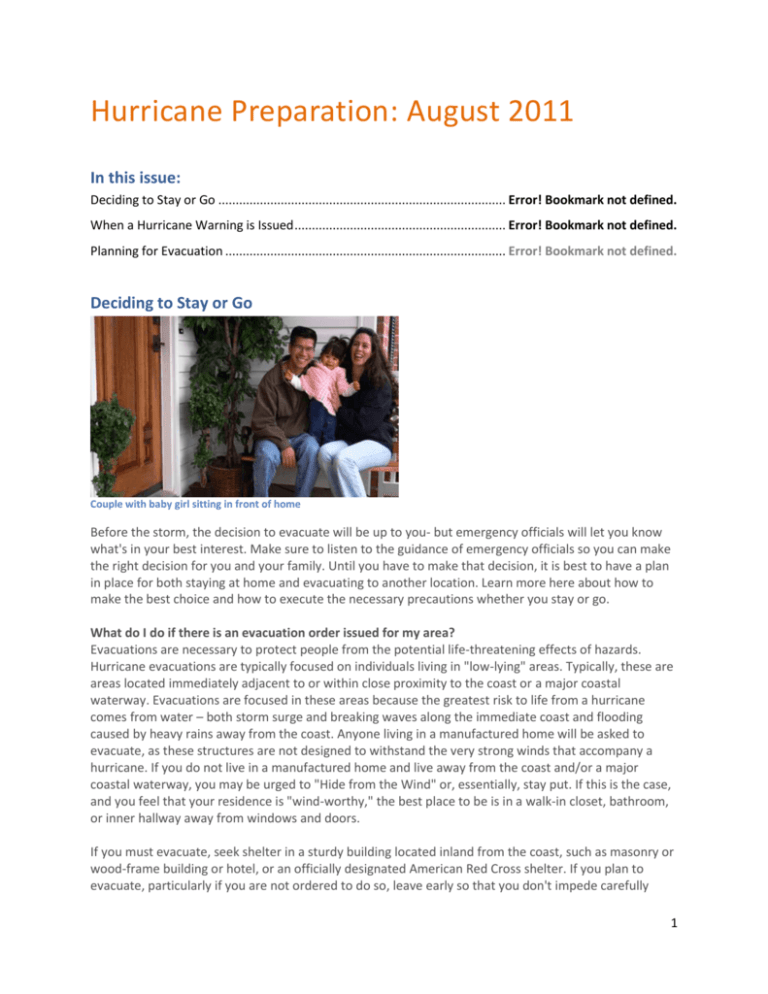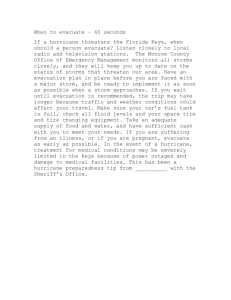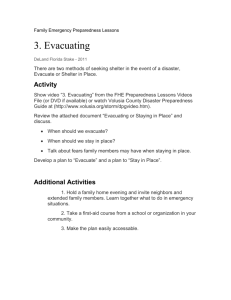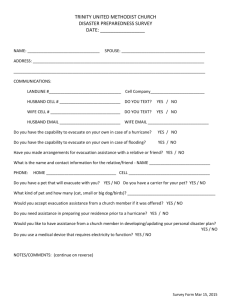BalancedLiving-HurricanePreparedness
advertisement

Hurricane Preparation: August 2011 In this issue: Deciding to Stay or Go ................................................................................... Error! Bookmark not defined. When a Hurricane Warning is Issued ............................................................. Error! Bookmark not defined. Planning for Evacuation ................................................................................. Error! Bookmark not defined. Deciding to Stay or Go Couple with baby girl sitting in front of home Before the storm, the decision to evacuate will be up to you- but emergency officials will let you know what's in your best interest. Make sure to listen to the guidance of emergency officials so you can make the right decision for you and your family. Until you have to make that decision, it is best to have a plan in place for both staying at home and evacuating to another location. Learn more here about how to make the best choice and how to execute the necessary precautions whether you stay or go. What do I do if there is an evacuation order issued for my area? Evacuations are necessary to protect people from the potential life-threatening effects of hazards. Hurricane evacuations are typically focused on individuals living in "low-lying" areas. Typically, these are areas located immediately adjacent to or within close proximity to the coast or a major coastal waterway. Evacuations are focused in these areas because the greatest risk to life from a hurricane comes from water – both storm surge and breaking waves along the immediate coast and flooding caused by heavy rains away from the coast. Anyone living in a manufactured home will be asked to evacuate, as these structures are not designed to withstand the very strong winds that accompany a hurricane. If you do not live in a manufactured home and live away from the coast and/or a major coastal waterway, you may be urged to "Hide from the Wind" or, essentially, stay put. If this is the case, and you feel that your residence is "wind-worthy," the best place to be is in a walk-in closet, bathroom, or inner hallway away from windows and doors. If you must evacuate, seek shelter in a sturdy building located inland from the coast, such as masonry or wood-frame building or hotel, or an officially designated American Red Cross shelter. If you plan to evacuate, particularly if you are not ordered to do so, leave early so that you don't impede carefully 1 planned evacuation procedures that plan for a certain number of cars occupying crowded roadways before a storm. Evacuations are planned well in advance and include "clearance time," which is the time it takes for all evacuees to reach a safe destination and to clear the roadways in advance of a storm. The bottom line is to make sure you have a plan – know what you're going to do and where you're going to go if an evacuation order is issued. In the event that an evacuation order is issued for your area, consider the following: Stay alert to storm advisories; know the difference between a hurricane watch and warning. Enact your family disaster plan. Map out your evacuation route – use travel routes specified by local authorities. DO NOT get on the road without a place to go. Fill your car with gasoline. Evacuate if told to do so – DO NOT get stranded. EVACUATE EARLY. If possible, evacuate to the home of either friends or family in a non-vulnerable area within your county. Next, try a motel or hotel and, as a last resort, go to a public shelter. Remember, shelters are not designed for comfort and do not usually accept pets. Enact your pet plan. Before a storm threatens, contact your veterinarian or local humane society for information on preparing your pets for an emergency. Bring your disaster supply kit, including important documents. Secure your home before leaving. Board up windows and glass doors, anchor loose yard objects or bring them inside and lock your doors. Get cash. Following a hurricane, banks and ATMs may be temporarily closed. Notify family and friends of your plans. People who require special assistance in evacuating should register with their local emergency management office. Where can I get more information about hurricane shelters in my area? There are many places to access information about shelters in your area. The best place to start is your state or local emergency management office or you can contact your local office of the American Red Cross (http://www.redcross.org). Where can I find information about what roads to take during an evacuation? In most cases, your state's Department of Transportation (http://www.dot.gov) determines which roads will serve as evacuation routes during emergencies. This information is typically available from the Department's Web site in the form of maps. Visit your state's Department of Transportation or Emergency Management (http://www.fema.gov) office to learn more. What is storm surge? Storm surge is simply water that is pushed toward the shore by the force of the winds swirling around a storm. This advancing surge combines with the normal tides to create the hurricane storm tide, which can increase the mean water level 15 feet or more. In addition, wind-driven waves are superimposed on the storm tide. This rise in water level can cause severe flooding in coastal areas, particularly when the storm tide coincides with the normal high tides. Because much of the United States' densely populated Atlantic and Gulf coastlines lie less than 10 feet above mean sea level, the danger from storm tides is tremendous. 2 What is the difference between an evacuation zone and a storm surge zone? Storm surge zones indicate areas subject to flooding from different categories of hurricane. Evacuation zones are areas, typically located within or in close proximity to storm surge zones. Emergency management officials use evacuation zone information to determine who needs to evacuate before a hurricane makes landfall. By becoming familiar with what zone you are located in, you can be better prepared to execute your plan when or if an evacuation order is issued for the zone in which you live. When a Hurricane Warning is Issued Man with tool-belt standing on ladder putting boards over windows When a hurricane warning is issued in your area, use these tips to weather the storm safely: Closely monitor radio, TV, or NOAA Weather Radio for official bulletins. Follow instructions issued by local officials. Leave immediately if ordered to do so. Complete preparation activities, such as putting up storm shutters, storing loose objects, etc. Evacuate all areas that might be affected by storm surge flooding or high winds. If evacuating, leave early (if possible, in daylight). Leave mobile homes in any case. Notify neighbors and a family member outside of the warned area of your evacuation plans. If You Are NOT Ordered to Evacuate The great majority of injuries during a hurricane are cuts caused by flying glass or other debris. Other injuries include puncture wounds resulting from exposed nails, metal, or glass, and bone fractures. To help you and your loved ones can get through the storm safely, please follow the guidelines below. Monitor the radio or television for weather conditions, if possible. Stay indoors until the authorities declare the storm is over. Do not go outside, even if the weather appears to have calmed---the calm "eye" of the storm can pass quickly, leaving you outside when strong winds resume. Stay away from all windows and exterior doors, seeking shelter in a bathroom or basement. Bathtubs can provide some shelter if you cover yourself with plywood or other materials. 3 Prepare to evacuate to a shelter or to a neighbor's home if your home is damaged, or if you are instructed to do so by emergency personnel. If You ARE Ordered to Evacuate Because of the destructive power of a hurricane, you should never ignore an evacuation order. Authorities will be most likely to direct you to leave if you are in a low-lying area, or within the greatest potential path of the storm. Be aware that most shelters and some hotels do not accept pets. If a hurricane warning is issued for your area or you are directed by authorities to evacuate the area: Take only essential items with you. If you have time, turn off the gas, electricity, and water. Disconnect appliances to reduce the likelihood of electrical shock when power is restored. Make sure your automobile's emergency kit is ready. Follow the designated evacuation routes---others may be blocked---and expect heavy traffic. Planning for Evacuation Evacuation Route Sign You should plan to evacuate before a hurricane strike if you… Live in a mobile home. Do not stay in a mobile home under any circumstances. They are unsafe in high wind and/or hurricane conditions, no matter how well fastened to the ground. Live on the coastline or on a offshore island, or live near a river or in a flood plain. Live in a high-rise. Hurricane winds are stronger at higher elevations. Glass doors and windows may be blown out of their casings and weaken the structure. 4 When evacuating.... Stay with friends or relatives or at a low-rise inland hotel or motel outside flood zones. Leave early to avoid heavy traffic, roads blocked by early flood waters, and bridges impassible due to high winds. Most public shelters do not allow pets nor do most motels/hotels, so make arrangements for your pets ahead of time. Hurricane shelters will be available for people who have no other place to go. Shelters may be crowed and uncomfortable, with no privacy and no electricity. Do not leave your home for a shelter until government officials announce on radio and/or television that a particular shelter is open. For more information and to create your own free hurricane plan, please visit OneStorm – http://www.onestorm.org. 5





